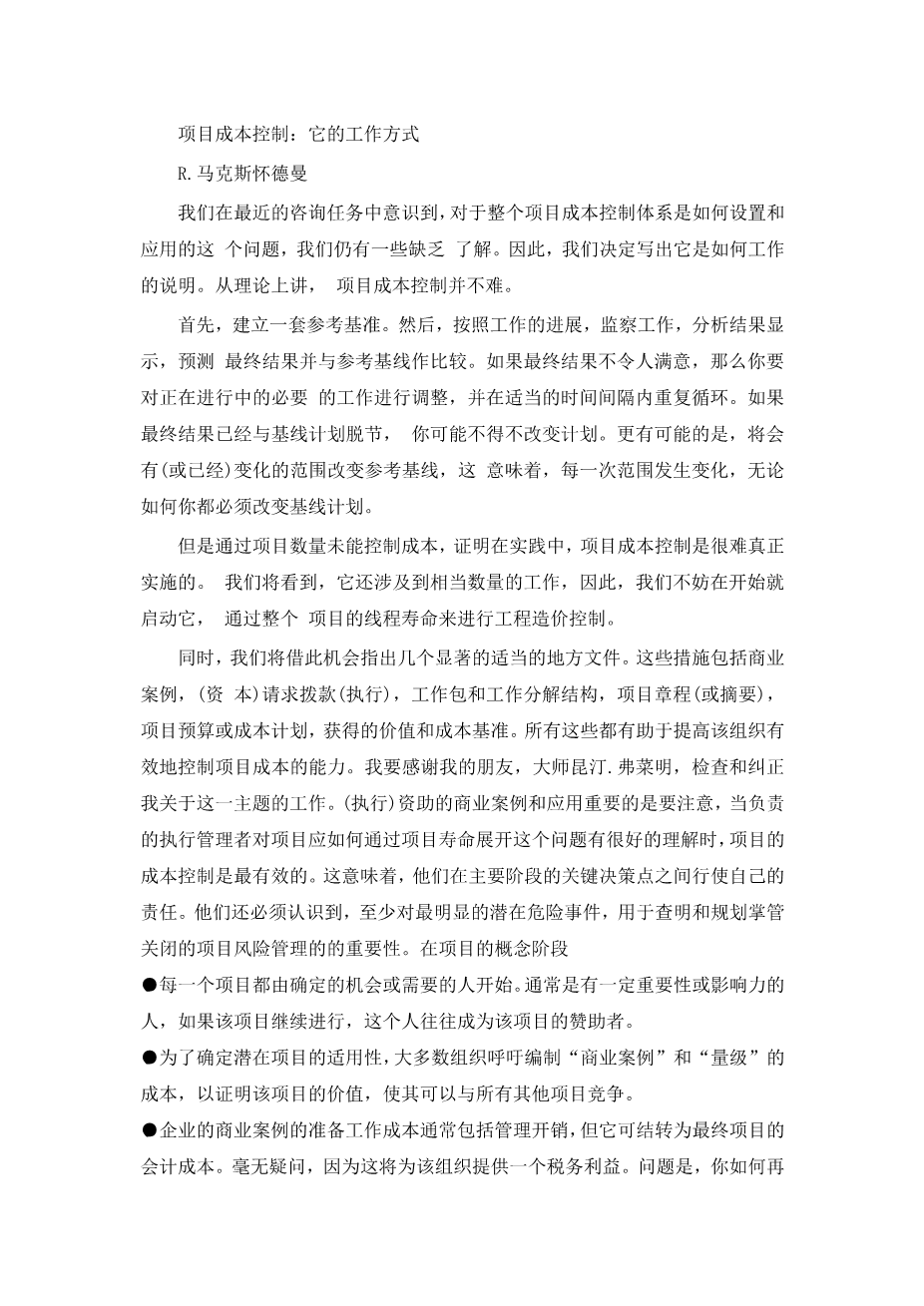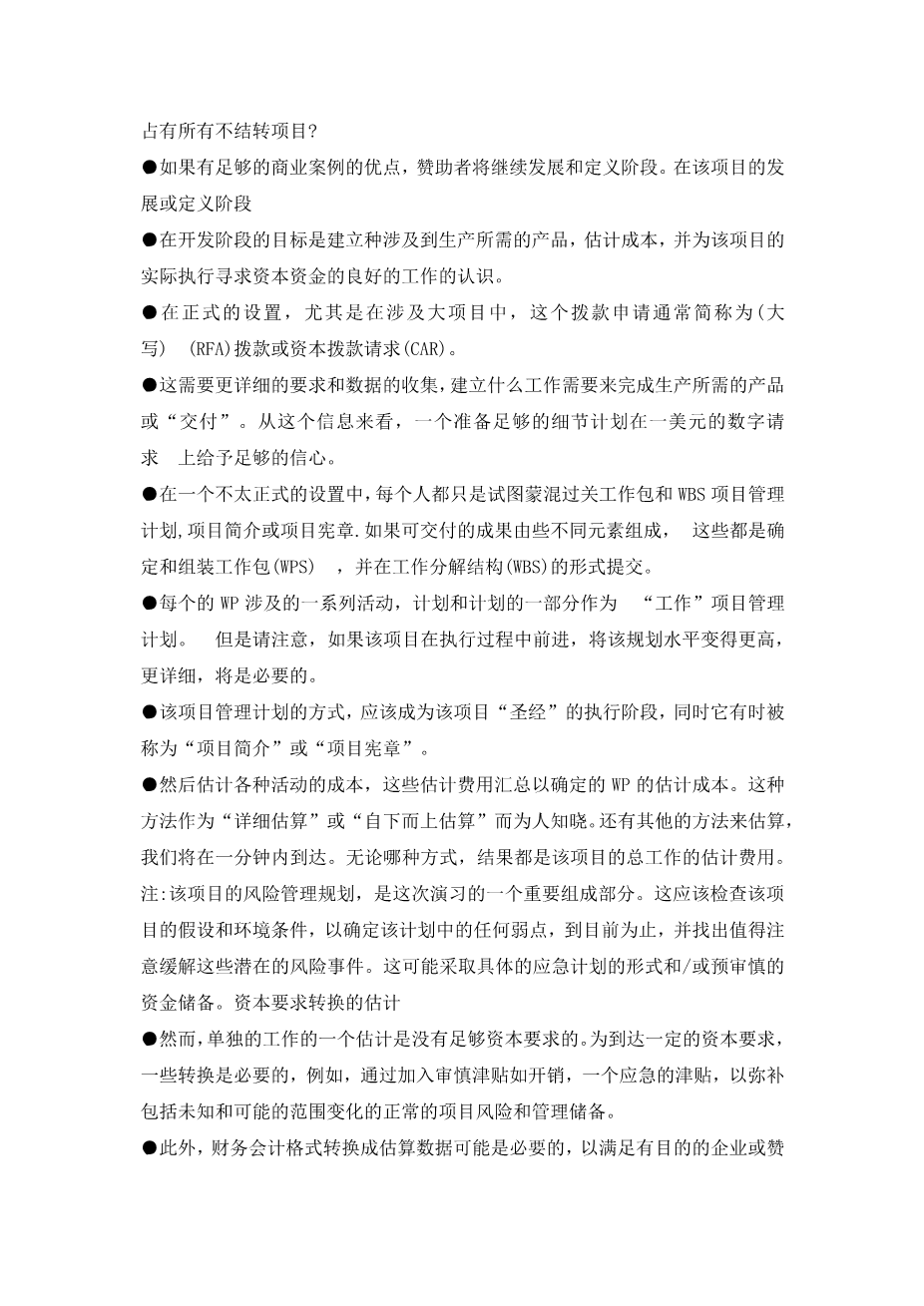Project Cost Control: The Way it Works
In arecent consulting assignment we realized that there was some lack of understanding ofthe whole system of project cost control, how it is setup and applied. So we decided to write up adescription of how it works. Project cost control is not that difficult to follow in theory.
First you establish a set of reference baselines. Then, as work progresses, you monitor thework, analyze the findings, forecast the end results and compare those with the reference baselines. If the end results are not satisfactory then you make adjustments as necessary to thework in progress, and repeat the cycle at suitable intervals. If the end results get really out of linewith the baseline plan, you may have to change the plan. More likely, there will be (or have been) scope changes that change the reference baselines which means that every time that happens youhave to change the baseline plan anyway.
But project cost control is a lot more difficult to do in practice, as is evidenced by the number of projects that fail to contain costs. It also involves a significant amount of work, as weshall see, and we might as well start at the beginning. So let us follow the thread of project costcontrol through the entire project life span.
And, while we are at it, we will take the opportunity to point out the proper places for
several significant documents. These include the Business Case, the Request for (a capital)Appropriation (for execution), Work Packages and the Work Breakdown Structure, the Project Charter (or Brief, the Project Budget or Cost Plan, Earned Value and the Cost Baseline. All of these contribute to the organizationamp;apos;s ability to effectively control project costs.
Footnote
I am indebted to my friend Quentin Fleming, the guru of Earned Value, for checking and correcting my work on this topic.
The Business Case and Application for (execution) Funding
It is important to note that project cost control is most effective when the executivemanagement responsible has a good understanding of how projects should unfold through theproject life span. This means that they exercise their responsibilitiethetkey decision points between the major phases. They must also recognize the importance of project risk managementfor identifying and planning to head off at least the most obvious potential risk events.
In the projectamp;apos;s Concept Phase
' Every project starts with someone identifying an opportunity or need. That is usually someoneof importance or influence, if the project is to proceed, and that person often becomes theprojectamp;apos;s sponsor.
' To determine the suitability of the potential project, most organizations call for the preparation of a'Business Case' and its 'Order of Magnitude' cost to justify the value of the project so that itcan be compared with all the other competing projects. This effort is conducted in the ConceptPhase of the project and is done as a part of the organizationamp;apos;s management of the entire project portfolio.
The cost of the work of preparing the Business Case is usually covered by corporate
management overhead, but it may be carried forward as an accounting cost to the eventual project.No doubt because this will provide a tax benefit to the organization. The problem is, how do youthen account for all the projects that are not so carried forward?
. If the Business case has sufficient merit, approval will be given to proceed to a Development and Definition phase.
In the projectamp;apos;s Development or Definition Phase
. The objective of the Development Phase is to establish a good understanding of the work involved to produce the required product, estimate the cost and seek capital funding for the actual execution of the project.
In a formalized setting, especially where big projects iavelved, this application for fundingis often referred to as a Request for (a capital) Appropriation (RFA) or Capital AppropriationRequest (CAR).
This requires the collection of more detailed requirements and data to establish what work needsto be done to produce the required product or 'deliverable'. From this information, a plan is prepared in sufficient detail to give adequate confidence in a dollar figure to be included in the request.
Ina less formalized setting, everyone just tries to mutidbegh.
Work Packages and the WBS
The Project Management Plan, Project Brief or Project Charter
. If the deliverable consists of a number of different elements, these are identified and assembledinto Work Packages (WPs) and presented in the form of a Work Breakdown Structure (WBS).
. Each WP involves a set of activities, the 'work' that is planned and scheduled as a part of theProject Management Plan. Note, however, that the planning will still be at a relatively high level,and more detailed planning will be necessary during execution if the project is given the go ahead.
. This Project Management Plan, by the way, should become the 'bible' for the execution phase of the project and is sometimes referred to as the 'Project Brief' or the 'Project Charter'.
·The cost of doing the various activities is then estimated and these estimated costs are
aggregated to determine the estimated cost of the WP. This approach is known as 'detailed
estimating' or 'bottom up estimating'. There are other approaches to estimating that weamp;apos;ll come to in a minute. Either way, the result is an estimated cost of the total work of the project.Note: that project risk management planning is an importanptart of this exercise. Thihouldexamine the projectamp;apos;s assumptions and environmental conditions to identify any weaknesses inthe plan thus far,
剩余内容已隐藏,支付完成后下载完整资料


英语译文共 6 页,剩余内容已隐藏,支付完成后下载完整资料
资料编号:[607773],资料为PDF文档或Word文档,PDF文档可免费转换为Word
您可能感兴趣的文章
- 饮用水微生物群:一个全面的时空研究,以监测巴黎供水系统的水质外文翻译资料
- 步进电机控制和摩擦模型对复杂机械系统精确定位的影响外文翻译资料
- 具有温湿度控制的开式阴极PEM燃料电池性能的提升外文翻译资料
- 警报定时系统对驾驶员行为的影响:调查驾驶员信任的差异以及根据警报定时对警报的响应外文翻译资料
- 门禁系统的零知识认证解决方案外文翻译资料
- 车辆废气及室外环境中悬浮微粒中有机磷的含量—-个案研究外文翻译资料
- ZigBee协议对城市风力涡轮机的无线监控: 支持应用软件和传感器模块外文翻译资料
- ZigBee系统在医疗保健中提供位置信息和传感器数据传输的方案外文翻译资料
- 基于PLC的模糊控制器在污水处理系统中的应用外文翻译资料
- 光伏并联最大功率点跟踪系统独立应用程序外文翻译资料



